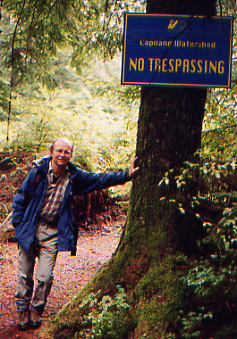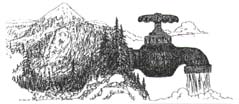| A life-long Vancouver resident, Will Koop suddenly became very
interested
in the history of the Greater Vancouver water supply watersheds in the
late Spring of 1991. His intense interest and enquiries eventually
led him, as an amateur researcher, to unravel a number of stories about
the history, conservation, controversy, politics, and the relatively
recent
mismanagement of these local consumptive use watersheds. |
 On February 6,
1992, Koop ventured forward to submit
his first rough and unedited draft of Wake
Up Vancouver to Greater
Vancouver publically elected representatives. He named report
in honor of an inspirational address by the co-founder of the Vancouver
Natural
History Society, John Davidson, which he presented in October 1924
before an audience of
about 300 people on the topic of the destructive logging practices in
the
Capilano watershed by the Capilano Timber Company. Large sections
of Koop's initial draft later appeared in a now defunct, but once very
popular,
magazine, Forest Planning Canada
(see September/ October 1992, Volume
8, Number 5, "A History of Vancouver's Watersheds"). On February
26, 1992, based on this report, the Vancouver Sun newspaper printed an
opinion piece by Koop on the controversial and secretive initiation in
the 1950's by the C.D. Schultz Company for a sustained-yield logging
program in the legislatively protected Greater Vancouver watersheds. In
April
1993, Koop revised his Wake Up Vancouver
Report, just after a local Vancouver paper, the
Georgia Straight, featured
the author on the front cover with an accompanying feature article. On February 6,
1992, Koop ventured forward to submit
his first rough and unedited draft of Wake
Up Vancouver to Greater
Vancouver publically elected representatives. He named report
in honor of an inspirational address by the co-founder of the Vancouver
Natural
History Society, John Davidson, which he presented in October 1924
before an audience of
about 300 people on the topic of the destructive logging practices in
the
Capilano watershed by the Capilano Timber Company. Large sections
of Koop's initial draft later appeared in a now defunct, but once very
popular,
magazine, Forest Planning Canada
(see September/ October 1992, Volume
8, Number 5, "A History of Vancouver's Watersheds"). On February
26, 1992, based on this report, the Vancouver Sun newspaper printed an
opinion piece by Koop on the controversial and secretive initiation in
the 1950's by the C.D. Schultz Company for a sustained-yield logging
program in the legislatively protected Greater Vancouver watersheds. In
April
1993, Koop revised his Wake Up Vancouver
Report, just after a local Vancouver paper, the
Georgia Straight, featured
the author on the front cover with an accompanying feature article.
|
| In April 1994, after examining the
history of the B.C. Electric Railway
Company, being B.C. Hydro's predecessor, Koop made his first (and
rather
long!) public presentation to the Port Moody Ecological Society on the
history of the Coquitlam River and watershed, which included
many photographic
slides from archival files. He elaborated on how the Coquitlam water
supply was protected expressly from all manner of logging in 1910 by a
federal Order-In-Council, a fact which the Greater Vancouver Water
District
has yet to document in their historical summaries to the public.
Koop also released confidential information on how B.C. Hydro's
predecessor
(the B.C. Electric Railway Company) had secretly and underhandedly
obtained
almost all of the City of New Westminster's water
rights, a condition which has recently (and may continue to) cost the
Water District and taxpayers hundreds of thousands of dollars in annual
rental fees.
|
| In February of 1995, after a
poorly detailed report by the Water District
on the effects of heavy winter rain storms causing landslides and road
washouts, Koop helped document, via a camcorder, whilst trespassing in
the Capilano watershed, the consequences that roads have in our
watersheds,
specifically one directly above the western side of the Capilano
reservoir.
Plugged culverts, roads flooded and washed out, road slides, the
release
of extremely fine clay sediments from cutslopes causing muddy turbid
water
transported directly into the reservoir. On March 10, 1995, Koop
presented a 22 page report, A Critique of the Landslide Report from
John Morse to the Water Committee, Being Item 2(D) of the February
10th,
1995 Water Committee Agenda, An Overview of Other Relevant Details
which
were not Reported on, and Some General Observations.
Shortly afterwards, videotape footage was given to the press and an
article
appeared on the front page of the Vancouver Sun's B section, which
brought
about television and radio coverage. What Koop did not realize at
the time of his February 26 visit to the Hollyburn road, was that it
was
going to present relevant evidence for a disaster which occurred eight
months later - the Capilano landslide.
|
| During the summer of 1995 the
Water District published a glossy, 18-page booklet for the public,
called Protecting a Precious Resource.
The
booklet, which was yet another public relations tool advocating
continued
logging in the watersheds, was to be distributed throughout the public
school system, and also distributed to people participating in the
summer
tours in the watersheds. On August 5, 1995, Koop distributed
another
22 page report, Misinforming the Public,
A Critique of the Greater Vancouver
Regional District's (GVRD') Watershed
Management Booklet, " Protecting a Precious Resource"
(A GVRD Excercise in
Controlling Information). Articles appeared in the press,
along
with another long radio interview. The associated events helped the
GVRD Board to change their policy regarding public access to the
watersheds,
to allow certain public groups access, a revised policy which has sadly
no teeth to it.
|
| Around October 9, 1995, there was a
reasonably large landslide which
plummeted directly into the northwestern sector of the Capilano
Reservoir.
At the October 13th Water Committee meeting, there was oddly no mention
of this catastrophic event to the publically elected members of the
Water
Committee by the Water District's Chief Engineer John Morse, a
situation
which was responsible for shutting down the reservoir for the next 6
months.
On October 15th, Koop physically located the isolated site, carefully
investigated
the landslide zone with video and photo documentation, and then
presented
the materials to the press. Over the next month and a half Koop then
produced a 56 page report, which included details on the related
logging
history in the area, and called it Not
Coming Clean: The Culvert Creek Landslide. A Report on the Recent
Landslide into the Capilano Reservoir, and the Greater VancouverWater
District's
Claims to the Public. The report was
presented to the Greater
Vancouver Regional District Board on December 8, 1995. The
report was also published well in advance of the Water District's own
report
by its geotechnical consultant, Thurber Engineering, which skirted
descriptive
historical assessment of the early logging in the area and the effects
that recent switchback road building may have contributed to the
landslide
failure.
|
| From February 1990 to the end
of 1996, Ben Marr's dual role was as
Commissioner of the Water District and Regional Manager of the Greater
Vancouver Regional District. Koop looked into the background of Mr.
Marr as a provincial bureaucrat, and then presented An
Open
Letter to Ben Marr, Manager
of the Greater Vancouver Regional
District, November 21st, 1996: Upon Your Retirement.
Under the
second long administrative reign of the Social Credit government
(1975-1991),
Marr had been the Deputy Minister of the Environment for 11 years
(until
1987), and almost 4 years as the Deputy Minister of Forests, the very
years
when the regulations and supervision over our provincial forests were
being
systematically rearranged and undermined.
|
| Since the 1991 public review over the
management of the Greater Vancouver
watersheds, the Water District was told to revise its March 1967
amended
agreement with the provincial government which removed the forty year
old
legislatively protected reserve to permit sustained yield logging in
the
watersheds. That revision of the revision did not transpire.
Koop investigated this failed process and, after a series of
correspondence
and presentations, he appeared before the Greater Vancouver Regional
District
Board and presented a long chronology on March 27, 1997, An
Overview
of Negotiations and Related Matters Between the Provincial
Government and the Greater Vancouver Water District Regarding the
Amending
Indenture. Despite the overwhelming amount of
detailed information,
and related logic, there was no future external response by the Greater
Vancouver Regional Board or by the Water District on this matter. [Note:
the chronological overview contains and capsulizes perhaps some of the
most critical information on the historical politics and policies
regarding
the Greater Vancouver watersheds.]
|
| Over the course of some years,
Koop had not only been attending monthly
Water Committee meetings, he also began attending Seymour Advisory
Committee
meetings and looking into its operational history. Koop
discovered
that the Seymour Advisory Committee was initially established in the
exclusive
company of professional foresters, and without the consent of the
Greater
Vancouver Regional District, to counter a proposal by three
municipalities
to make the Lower Seymour off-catchment lands into a public regional
park.
The history of that private counter-process eventually led him to
publish
his latest December 10, 1997, 118 page report, Seymourgate,
The Off-Catchment Lands of the Lower Seymour Valley. An
Investigation
Into: The History of the Lower Seymour; The First Regional Park
Proposal;
The Seymour Advisory Committee and the Related Establishment and
Operation
of the Seymour Demonstration Forest.
|
| In the summer of 1999, near
the end of the Ecological Inventory process,
an expensive consultant-based study and report contract for the three
Greater
Vancouver watersheds, with an emphasis on the Capilano watershed, Will
Koop began writing a report on the ecological inventory process for the
Society Promoting Environmental Conservation (SPEC), since his
involvement with
them for a public campaign to end logging in the watersheds. Silty
Sources: A Critique of the GVRD's Ecological Inventory Project Annex
and
Analysis Reports, was finished on November 1, 1999, and
presented
to the Greater Vancouver Regional District Directors on November 10,
1999,
along with a photo-slide presentation, when the Board voted to end
logging
in the three watersheds. |
| Note: All of
the reports mentioned above are available in print form
in the Greater Vancouver Public Library system. There has never been
a proper and complete history written on any of the Greater Vancouver
catchments
regarding social and resource use issues, including the only two
relevant
titles of James W. Morton's Capilano:
The Story of a River; and
Gabrielle Kahrer's historical summary of the Seymour, which she
completed
under a contract for the Greater Vancouver Water District, From Speculative
to Spectacular: The Seymour River Valley 1870s to 1980s, A History of
Resource
Use. Morton's Capilano, which is well written and still
popular
among local historians and residents, captures some important episodes
and character studies in the early years, but lacks a sweeping and
summary
analysis of the evolving controversies and intrigue surrounding the
logging
issue.
|
|

